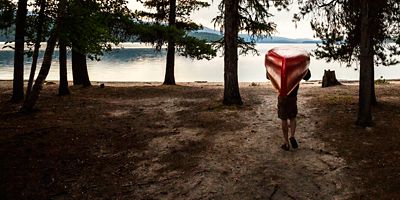So you’ve got a canoe. Nice work: You’ve started a sport that can sustain your interest the rest of your life and that offers you, and your family, some of the most unique access possible to the outdoors. Before you join a long line of early Voyageurs before you, you’ll need to polish up on a few paddling pointers to make your outing as enjoyable as possible. Beyond the initial gear and safety equipment, you need to understand how to deal with the biggest contingency you might encounter—a capsize—before you load up and launch.
Paddling Prepared
While you’re not likely to capsize your canoe—they’re built to be stable—mistakes do happen. If you flip near shore, which sometimes occurs while entering or exiting, simply drag or swim it to shallow water where you can empty it and climb back in. If you capsize away from shore, it gets trickier, with several techniques that depend on the situation. Note that to safely employ any of these options, you’ll need to be dressed for immersion (according to the temperature of the water, not the air) and wearing a properly fitted PFD, as they each involve time and the ability to maneuver in the water—two things that you might not have if you paddle unprepared.
If Capsized With a Partner
If you flip while paddling with a partner, try the Capistrano Flip. Get underneath the canoe at opposite ends, facing each other while treading water. Using strong scissors-kicks, raise one side of the canoe to break the suction and then heave the raised side up and over so the canoe flips back upright. (This can be tricky with a heavy or loaded canoe; you may need to untie or empty equipment to flip over). From there, move to the canoe’s center and rock it gently back and forth, splashing out additional water. Next, position yourselves at opposite ends of the canoe and have one person stabilize it from the water while the other climbs in, staying low and balanced. Then have the second person enter the canoe by using a scissors-kick to grab the opposite gunwale and climb in, also staying low and balanced. You can also try to both climb in simultaneously to keep the weight balanced.
Canoe to Canoe Rescue
If you’re coming to the aid of another canoe that has flipped, position your canoe at a right angle to the overturned canoe, with the swimmer(s) positioned at either end of your canoe to help stabilize it. Twist the overturned canoe to break the surface tension and then hoist the upside-down canoe across the gunwales of your canoe to drain it. Then slide it back into the water upright alongside your canoe, and reach over to help stabilize it as the swimmer(s) climb back in.
If Capsized Solo
If you capsize a canoe paddling solo, employ what’s called the Deep-water Shake-out. To start, roll the canoe over so it’s right-side up, full of water. To drain it, go to one end and push down, letting as much water out as possible. Next, move to the middle of the canoe, grab the gunwale with both hands and gently rock the boat back and forth, causing additional water to splash out. Re-enter by gripping the far side to pull yourself up on your stomach, rotating your butt at the last second to slip down to the floor. Next, you’ll need to bail out any additional water with a bucket, simple modified milk jug, or bilge pump.





